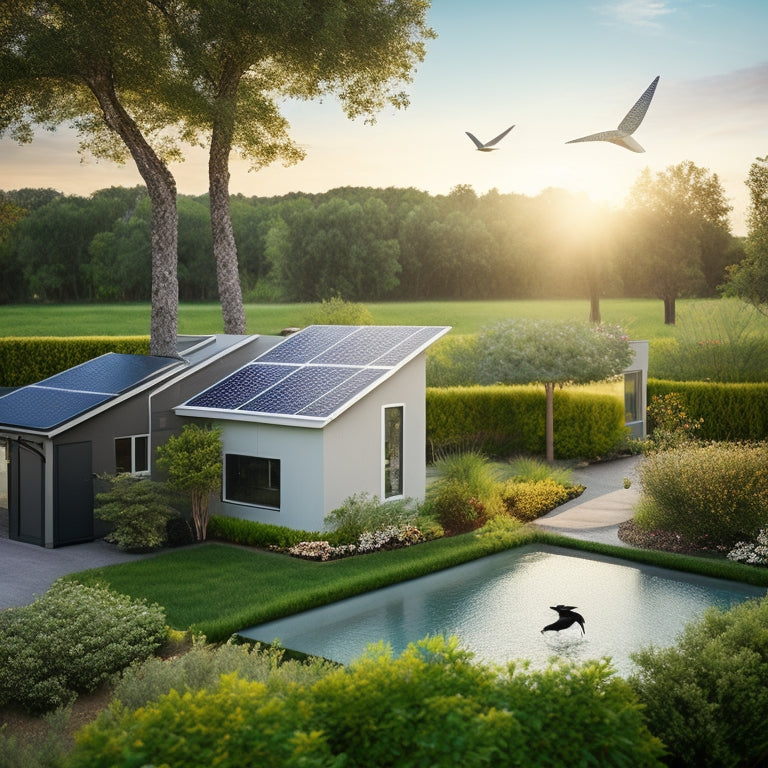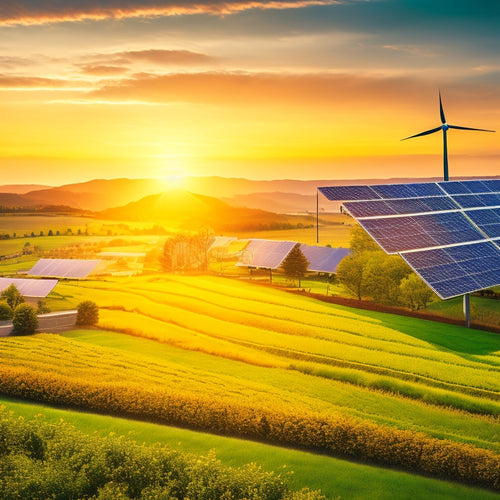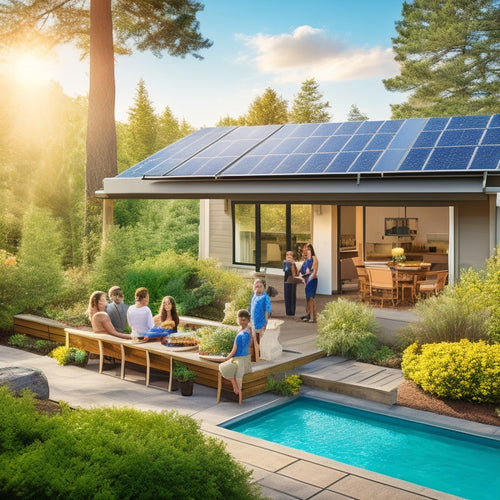
5 Essential Home Energy Freedom Systems
Share
When prioritizing home energy freedom systems, you should focus on five essential components. First, consider solar panel costs, which vary depending on quality, efficiency, and installation. Next, energy storage systems provide cost savings and independence during grid outages. Inverters are essential for converting DC power to AC, and choosing the right type is critical. Selecting the ideal battery type, such as lithium or lead acid, depends on your energy needs, budget, and maintenance preferences. Finally, optimizing your system through regular monitoring, accurate power calculations, and sustainable practices guarantees maximum efficiency and cost savings; now, learn how to guarantee these components work together seamlessly.
Overview
- Invest in high-quality solar panels with high efficiency to maximize energy harvesting and reduce costs in the long run.
- Incorporate energy storage systems to store excess energy and achieve energy independence during grid outages.
- Choose the right inverter type, such as grid-tie or off-grid, to ensure efficient conversion of DC power to AC power for home use.
- Select the suitable battery type, considering factors like energy density, lifetime, and maintenance requirements, to optimize energy storage.
- Monitor and fine-tune your system's performance regularly to minimize energy waste and maximize energy freedom.
Understanding Solar Panel Costs
When considering a home energy freedom system, understanding solar panel costs is an essential step in determining the feasibility of switching to renewable energy.
You need to know what to expect from solar panel pricing, as it varies depending on the quality, efficiency, and brand of the panels. The type and quality of equipment significantly impact costs, and high-quality equipment from reputable suppliers guarantees reliability, durability, and performance.
Average solar panel pricing ranges from $2.50 to $3.50 per watt, with a typical residential system requiring around 5,000 to 10,000 watts.
Installation expenses, including labor and equipment, add to the overall cost, typically ranging from $15,000 to $30,000 for a standard residential system.
Benefits of Energy Storage Systems
Reliability is key to accessing the full potential of your home energy freedom system, and energy storage systems play an important role in achieving it. By incorporating energy storage, you'll be able to store excess energy generated by your solar panels during the day for use at night or during power outages. This enhances your energy independence, reduces your reliance on the grid, and decreases your environmental impact.
| Benefits | Description |
|---|---|
| Cost Savings | Reduce your electricity bills by storing excess energy for later use |
| Energy Independence | Power your home even when the grid is down |
| Grid Reliability | Smooth out grid fluctuations and reduce peak demand |
| System Longevity | Protect your system from wear and tear, increasing its lifespan |
The installation process is relatively straightforward, and the benefits far outweigh the costs. By investing in energy storage, you'll be taking an essential step towards achieving true energy freedom.
Inverters for Home Solar Power
With energy storage in place, you've taken a significant step towards achieving home energy freedom.
Now, it's time to contemplate the inverter, an important component that converts DC power from your solar panels to AC power for your home. You'll need to decide between a grid-tie inverter, which synchronizes with the grid, or an off-grid inverter, which operates independently.
Inverter efficiency is vital, as it directly affects your system's performance. Proper system sizing is also essential, as an undersized inverter can lead to energy losses.
To guarantee maximum performance, it's important to evaluate daily energy usage and roof space for appropriate inverter sizing, and take into account inverter efficiency ratings, such as CEC, for peak energy conversion.
There are various inverter types, including string, micro, and power optimizers.
When installing your inverter, make sure it's protected from the elements and easily accessible for maintenance.
Choosing the Right Battery Type
As you venture into the domain of home energy freedom, selecting the right battery type is essential for a seamless and efficient energy storage system.
You'll need to evaluate the pros and cons of each option. Lithium batteries offer several advantages, including higher energy density, longer lifetimes, and lower maintenance requirements, which is why they've a lower environmental impact compared to traditional battery types.
Additionally, their high energy density enables compact design for portable electronics and vehicles. However, they're often more expensive upfront.
Lead acid batteries, on the other hand, are more affordable but have lower energy densities, shorter lifetimes, and require more maintenance.
When choosing between these options, contemplate your energy storage needs, budget, and desired level of maintenance.
Assessing these factors will help you select the ideal battery type for your home energy freedom system.
Optimizing Your Energy Freedom
You've selected the ideal battery type for your home energy freedom system, now it's time to optimize its performance.
To maximize energy efficiency, monitor your system's performance regularly, identifying areas for improvement. Accurate power calculations and battery capacity assessments, such as conducting thorough load profiling, are essential in minimizing energy waste.
Implement sustainable practices like adjusting your energy usage patterns, optimizing your load shedding strategy, and fine-tuning your charging and discharging schedules.
Consider integrating energy-efficient appliances and lighting to reduce your overall energy consumption.
Frequently Asked Questions
Can I Install an Energy Freedom System Myself?
You can attempt a DIY installation, but it's essential to weigh the risks versus system benefits, as improper setup can compromise efficiency and safety, ultimately defeating the purpose of achieving energy independence.
How Long Does It Take to Charge an Energy Storage System?
As you envision your energy independence, you're probably wondering how long it takes to charge your energy storage system. The answer depends on charging efficiency and battery capacity - typically, a 10kWh battery takes 2-5 hours to fully charge with a 3kW charger.
Do Energy Freedom Systems Work During Power Outages?
You'll rest easy knowing energy freedom systems keep your lights on during power outages, ensuring power reliability through outage preparedness; they seamlessly switch to stored energy, providing uninterrupted power supply when the grid fails, giving you true energy independence.
Are Energy Freedom Systems Compatible With All Roof Types?
Like a puzzle piece, you're wondering if energy freedom systems fit seamlessly with all roof types; the answer is, they're compatible with most, but installation requirements vary depending on roofing materials, such as asphalt, metal, or tile, requiring customized solutions.
Can I Expand My Energy Freedom System in the Future?
You can easily expand your system in the future, allowing for seamless system expansion and future upgrades, giving you the flexibility to adapt to changing energy needs and technological advancements.
Ready to Buy
By incorporating these 5 essential home energy freedom systems, you'll be well on your way to reducing your reliance on the grid. Take, for example, the Nelsons, who installed a solar panel system with energy storage and optimized their energy usage. They've reduced their energy bills by 90% and haven't looked back. With the right system in place, you too can experience the freedom and savings that come with generating and managing your own energy.
Related Posts
-

Net Metering in Renewable Energy's Future
Net metering's future is vital for driving renewable energy growth and financial savings. You can reduce your electri...
-

Top Camping Water Bottles for Adventure
When you're out adventuring, picking the right camping water bottle is essential for staying hydrated. Look for durab...
-

Top-Rated Home Solar Power Kits for Achieving Energy Independence
Top-rated home solar power kits enable you to achieve energy independence by greatly cutting your energy costs. You c...


